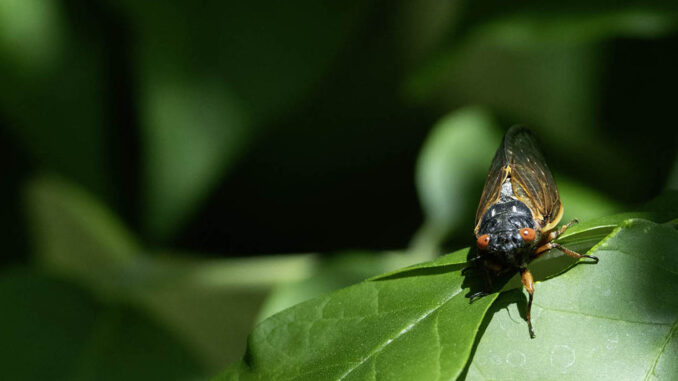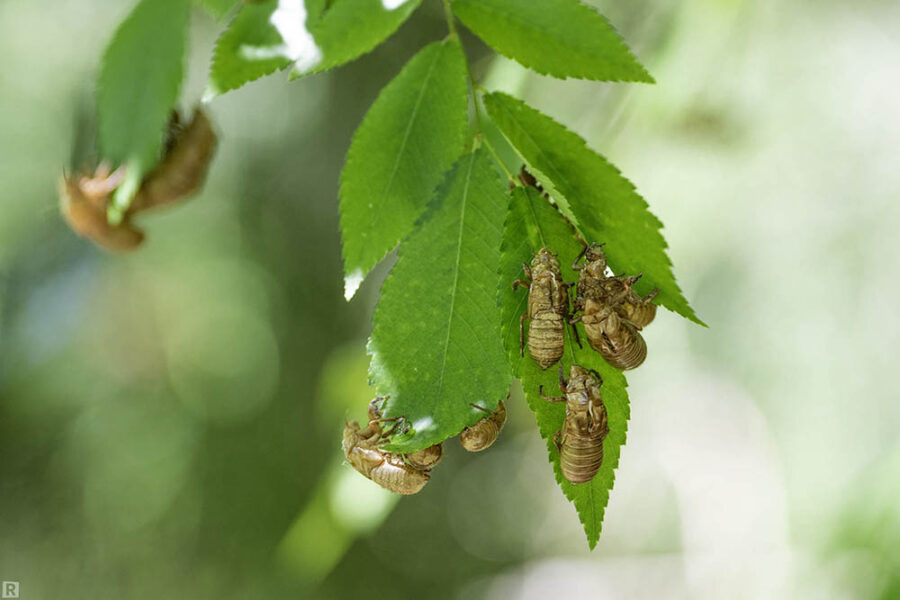
North Carolina is currently experiencing a phenomenon 13 years in the making. Millions — and perhaps billions — of cicadas have emerged from underground for their mating season.
“When the ground reaches a certain temperature (around 64 degrees F, usually around May in N.C.), the nymphs that have been underground — slowly sucking sap from tree roots — dig their way up to the surface,” explained Matt Bertone, director of the Plant Disease and Insect Clinic at NC State, in an article on the N.C. State College of Agriculture and Life Sciences website.
Once the nymphs have emerged, the males begin calling to them — the sometimes deafening call that has been annoying folks from the northern part of the state down to the South Carolina line.
The website Cicada Mania explains how the cicadas make their loud mating calls: “Males sing by flexing their tymbals, which are drum-like organs found in their abdomens. Small muscles rapidly pull the tymbals in and out of shape. The sound is intensified by the cicada’s mostly hollow abdomen.”
Bertone added: “These calls are deafening on their own, but when millions are ‘singing,’ it becomes a wall of sound.”
“It’s kind of crazy,” Debbie Roos, a Cooperative Extension agent in Chatham County, told North State Journal. “It’s been a topic of conversation for everybody around here. I was just giggling to myself when I came back from lunch because they were so loud.”
Two broods are currently emerging around the eastern part of the country, but only one — Brood XIX — can be found in North Carolina, Bertone told North State Journal. “They are a 13-year cicada, meaning they emerge every 13 years,” he explained. “This brood is huge; it stretches across the eastern United States.”
Not all of North Carolina is experiencing the overwhelming cicada call, however. The counties that are seeing the brood boom include Buncombe, Cabarrus, Chatham, Davidson, Davie, Durham, Gaston, Guilford, Mecklenburg, Montgomery, Orange, Randolph, Rowan, Stanly, Union and Wake.
“They don’t travel far,” Roos explained. “Wherever they are, they drop to the ground and that’s where they stay for the next 13 or 17 years, depending on what kind of cicada they are.”

That’s why certain parts of the state are experiencing the cicada emergence while others are just wondering what all the fuss is about. “It’s really hit or miss,” Roos said. “There are just pockets of them here and there.”
“Once they have mated,” Bertone said, “females use their drill-like ovipositor to cut into the branches of various trees and woody plants, laying hundreds of eggs inside. After a few weeks, the adults will die out and the young will hatch from the branches and drop to the ground below. There, they will burrow next to a root and tap in for the long haul, feeding on the juices of the plant for 13 years.”
All of this means that while the cicadas are mating and preparing to go underground for the next 13 years, we humans are experiencing their overwhelming calls and wondering what it means for us. Well, it turns out the cicadas are harmless to humans, but they can affect smaller plants and agricultural plants with lots of wood, Bertone said.
“They don’t target old, healthy trees, so there’s no need to worry about that,” he explained. “They do like kind of small, susceptible plants.”
Roos pointed out that young plantings of blueberries, fruit trees, brambles, grape vines or other woody trees could be especially susceptible to cicada damage. “If only a few branches are damaged, they can be pruned out, but when the majority of branches are significantly damaged, the young tree or bush might need to be replaced,” she said.
In order to protect these young plants, Bertone suggested using netting around any susceptible bushes or small trees. “People need to make sure the netting is closed pretty tightly around the trunk so the cicadas can’t burrow their way through,” he said.
As for how long the cicada “invasion” is expected to last, Bertone said there’s no way of knowing for sure, but it will probably continue through this month and possibly into June.
“It’s a phenomenon that’s pretty special on our planet,” Bertone said. “We’re lucky to be able to experience it.”
He added that there will be another brood emerging next year in the western part of the state, but after that, it may be a few years before there’s another.
“It’s an interesting little phenomenon,” Roos said, “so just enjoy them while they’re here.”



